It’s 2020. The world has gone dark. Cities are silent, markets are trembling, and the Nasdaq is glowing like a campfire in the storm.
Somewhere in Cupertino, Tim Cook is watching iPhone sales surge while everyone’s locked indoors.
In Redmond, Satya Nadella is running a global experiment in remote work from his living room.
Jeff Bezos is timing deliveries down to the minute, while Elon Musk is tweeting at Mars and printing billions in market cap.
It feels absurd, markets at record highs while the world is falling apart. But this is where our story begins.
2020 — The Great Compression
When the pandemic turned life inside out, the Mag 7 turned it into a business model.
Apple and Microsoft became oxygen. Every home became an office. Every screen became a workspace.
Amazon was the new national utility– the company that kept the lights on when everything else went dark.
Meta and Alphabet stumbled for a moment, then rocketed back as the world realized “digital” wasn’t an option anymore — it was the only reality.
Nvidia quietly became the unseen engine behind it all: data centers, AI experiments, gaming rigs, the architecture of the internet.
And Tesla? Tesla went from an idea to a religion.
By December, the market was no longer a reflection of the economy — it was a reflection of innovation.
Here’s how the comparative chart looked.
Look at Tesla- every other stock performance looks muted compared to its 700% in 1Y. Apple and Microsoft climbed more than 50%.
The S&P 500? Barely 18%. The message was clear: the digital century had officially started.
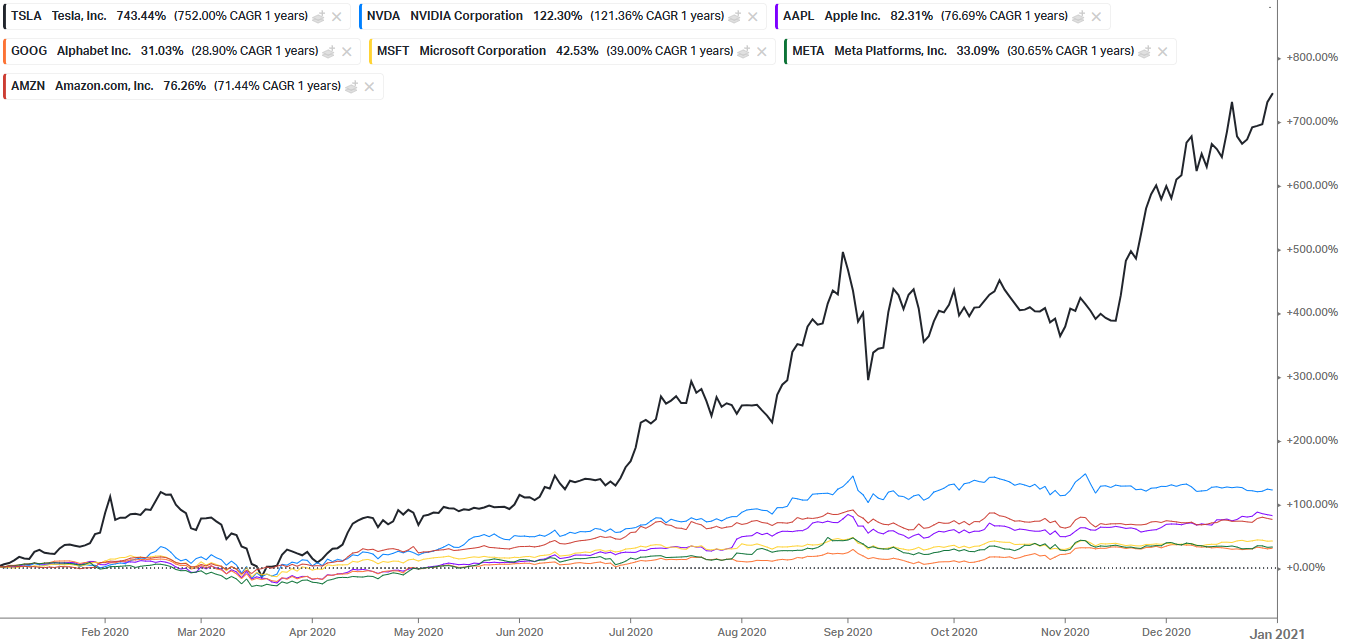
2021 — The Expansion Arc
Reopening didn’t stop them — it stretched them.
The Mag 7 were no longer “tech stocks.” They were the market.
Microsoft’s cloud became infrastructure for civilization. Apple kept minting money while pretending to sell phones.
Nvidia caught lightning in a bottle as AI research escaped the lab and entered the boardroom.
Amazon stumbled under its own size — too many warehouses, too many hires — but AWS kept the story alive.
Meta and Alphabet printed ad profits like it was a public service. Tesla proved it could scale production while still breaking physics.
The index rose 27%. The Mag 7 outpaced it again. What was once a “pandemic trade” had become a structural re-rating of modern capitalism.
Here’s how the stocks looked after 2 years.
TSLA crossed the mighty 1000% in 2Y mark- NVDA was up 400%, the others still competing, but ahead of the market.
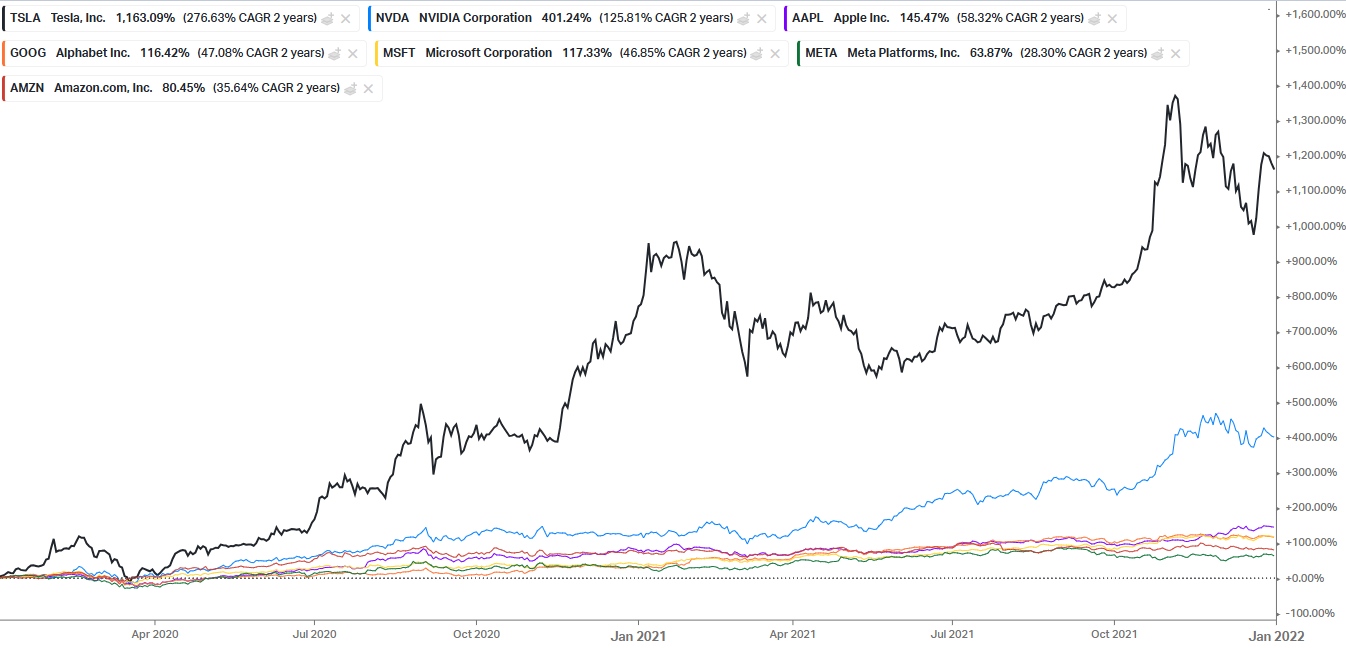
2022 — The Reckoning
Every bull market has its hangover.
Rates surged, inflation hit, and suddenly everyone remembered valuation math.
The bubble talk began. Nvidia fell 50%. Tesla was cut in half.
Meta imploded — down 65% — punished for a metaverse nobody wanted and a privacy rule it couldn’t control.
Amazon’s profits vanished under the weight of overcapacity. Apple and Microsoft held up better, but even they lost altitude.
For a moment, it felt like gravity was back. The question wasn’t just “are these stocks overvalued?”
It was “can the market exist without them?”
The charts tell the story, look at Tesla plummeting 600% in a year.
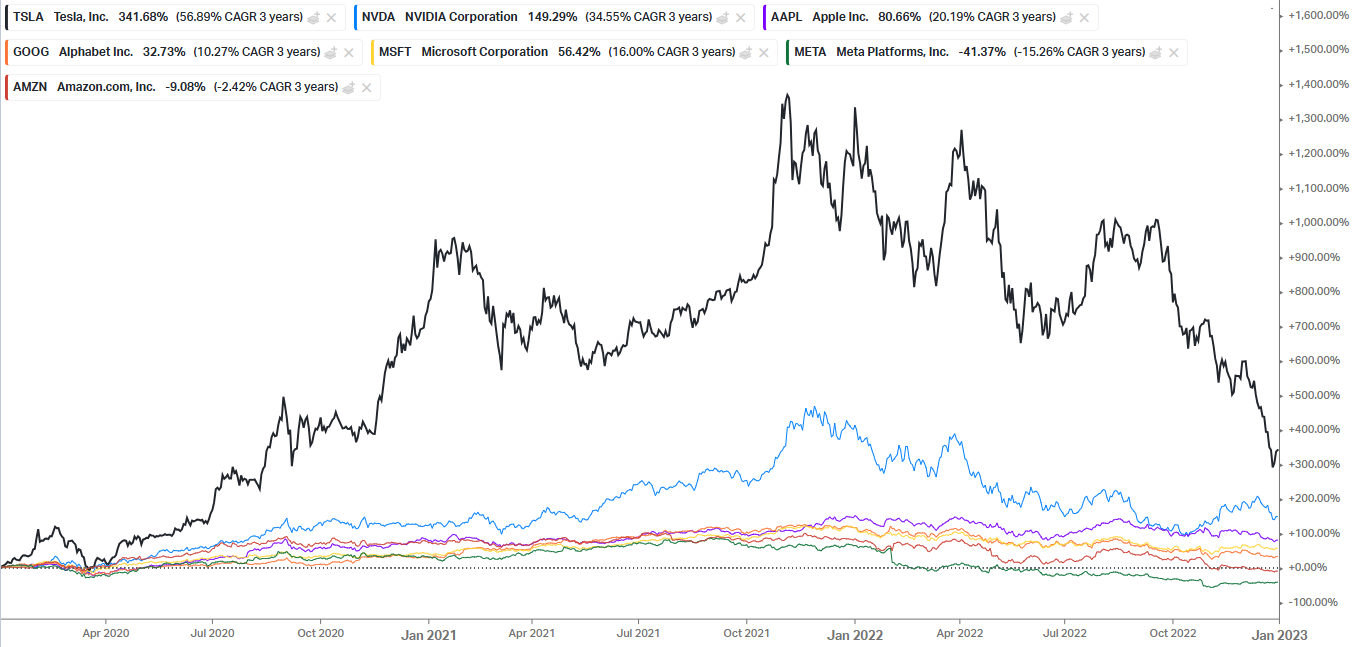
2023 — The AI Awakening
You could feel it. Something was stirring.
ChatGPT went mainstream. CEOs started saying “AI” on every earnings call. And suddenly, the Mag 7 were back — faster, stronger, more profitable than ever.
Nvidia didn’t just recover; it detonated.
A 240% surge turned it into the most important company on earth.
Microsoft embedded AI into everything it sold and watched its multiple expand again.
Meta reinvented itself as a lean, efficient machine.
Amazon rediscovered profitability. Alphabet held its own.
Even Apple, quiet as ever, showed up with a record $100B in net income.
The market’s biggest fear — that the Mag 7 were a bubble — flipped into awe.
Together, they rose ~75% that year, driving nearly all of the S&P 500’s gains.
Without them, 2023 would have been a flatline.
The chart– TSLA rose to 790%, NVDA catching up with 740%, the rest were high, but still muted.
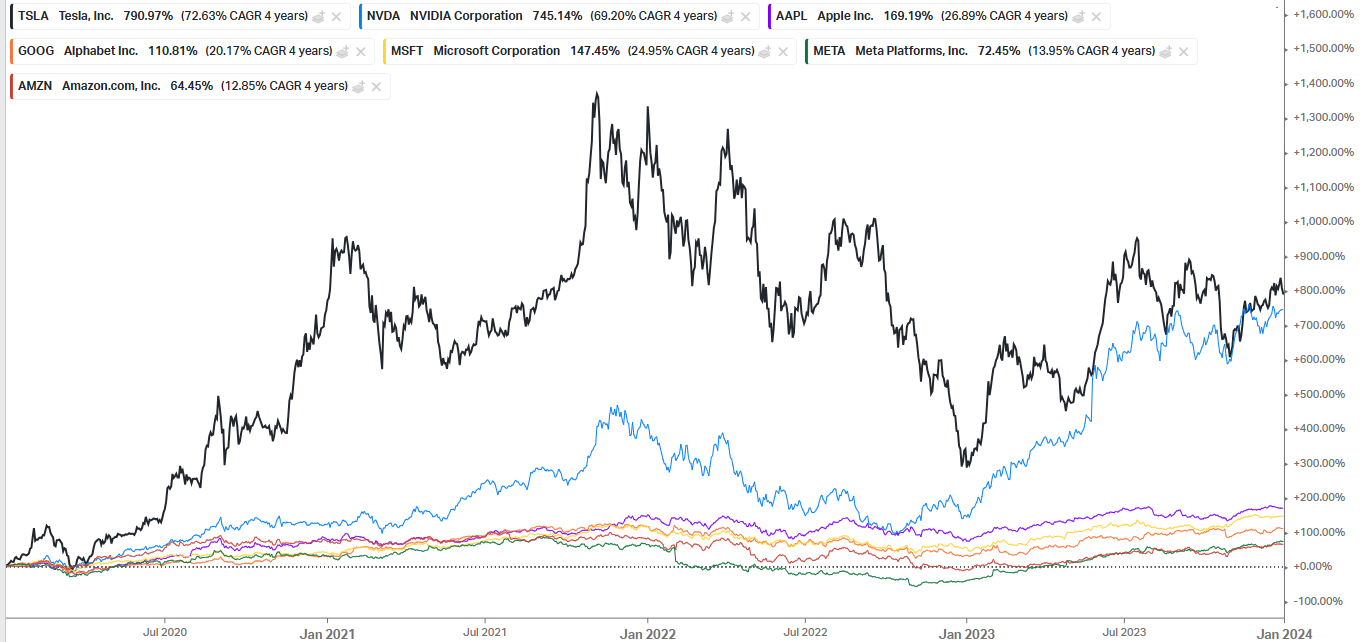
2024 — The Shift Beneath the Surface
By 2024, it wasn’t about whether the Mag 7 could rally. It was which ones would.
Nvidia stayed center stage, but the spotlight widened — TSMC, Broadcom, and utility grids joined the cast.
Microsoft quietly monetized AI better than anyone.
Meta poured billions into infrastructure but gave just as much back to shareholders.
Amazon balanced cost discipline with growth.
Alphabet proved that AI wouldn’t kill its search margins after all.
Apple played its usual game: no hype, just execution.
Tesla faced its first real rivals, its margins compressing under competition and higher rates.
The index stayed strong, but the era of uniform leadership was over.
The Chart- NVDA overtook TSLA and all others by a nautical mile. It was up ~2,100% compared to TSLA’s 1348%.
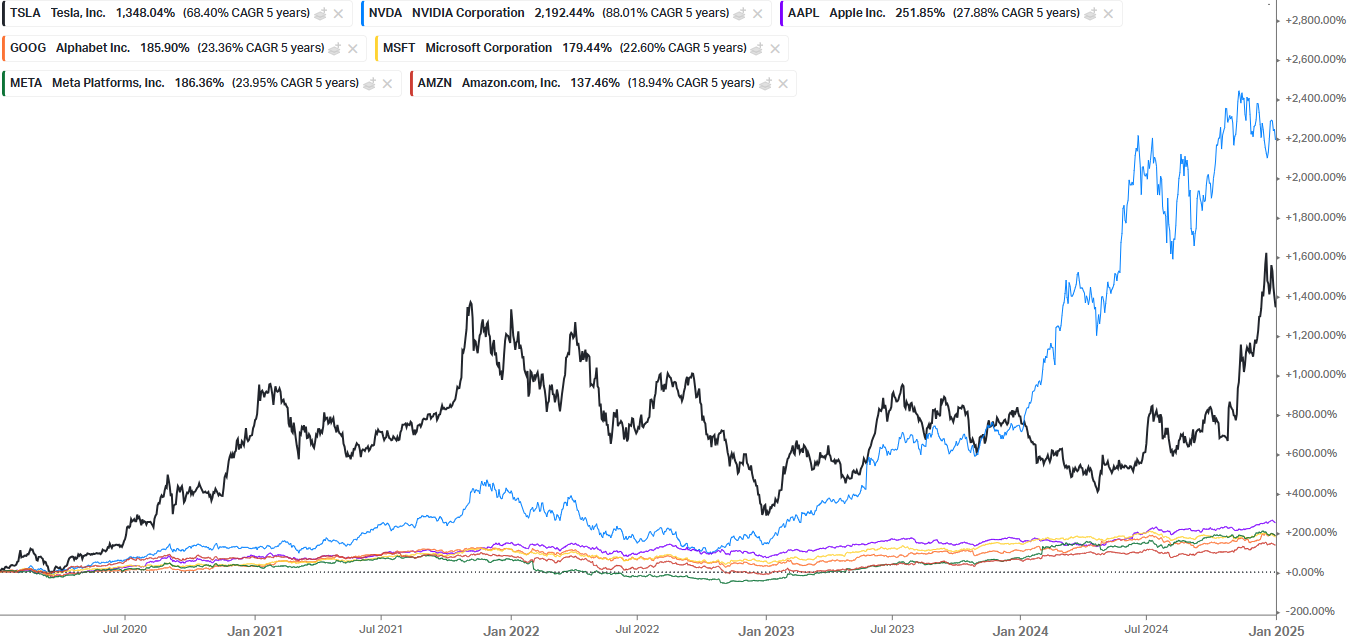
2025 — The Year of Endurance
Now the story’s different. The Mag 7 aren’t racing — they’re sustaining.
AI is no longer a buzzword; it’s an industry. Power, chips, networking, and cooling are the new frontiers.
Nvidia’s dominance endures, but so does Microsoft’s monetization engine.
Meta and Alphabet are cash-rich and focused. Amazon is efficient. Apple’s ecosystem keeps it relevant in every pocket. Tesla’s proving it’s more carmaker than cult.
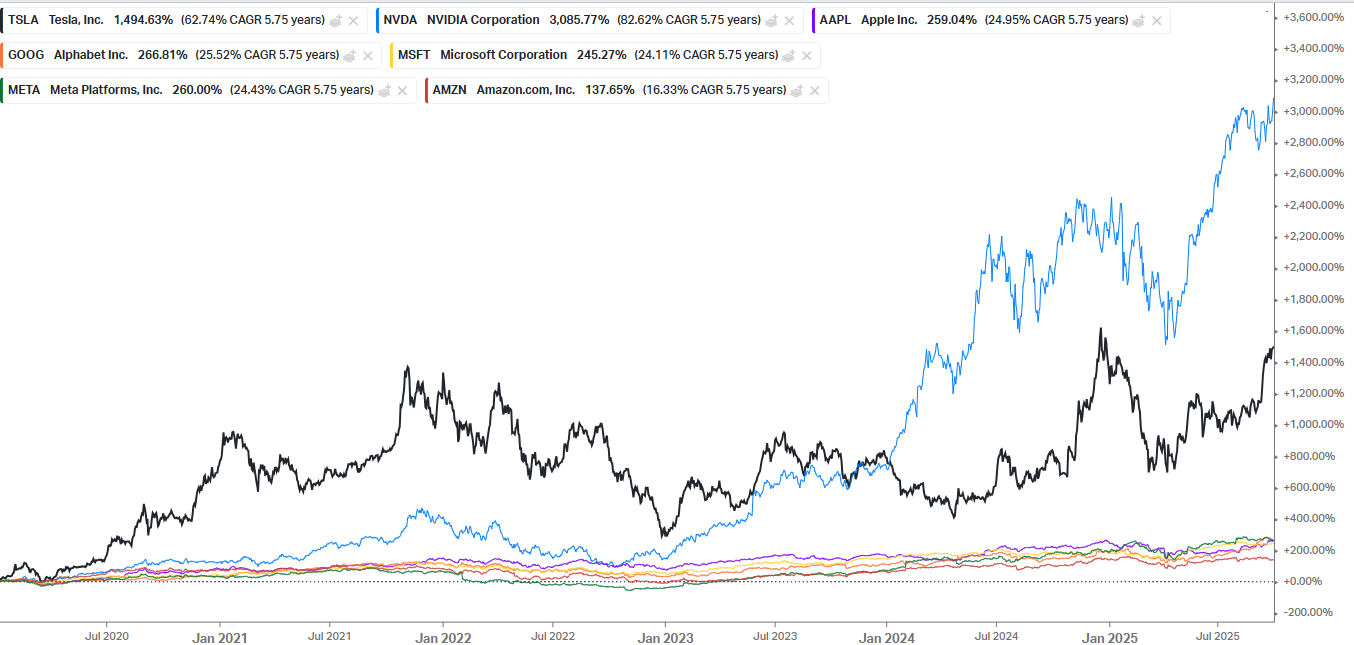
The scoreboard tells the tale:
- Nvidia: +3,085% in five years.
- Tesla: +1,495%.
- Microsoft: +250%.
- Apple: +260%.
- Meta: +260%.
- Amazon: +140%.
- Alphabet: +265%.
Together, they’re up nearly 300% — while the S&P 500 is up less than 100%.
The Closing Scene
So when someone says, “The market’s overvalued,” just smile.
Because what they’re really seeing is what happens when seven companies compound innovation faster than anyone thought possible.
These aren’t lottery tickets; they’re economic engines.
The Mag 7 didn’t just ride the market — they became the market.
And if history’s any guide, the sequel’s already being written.
